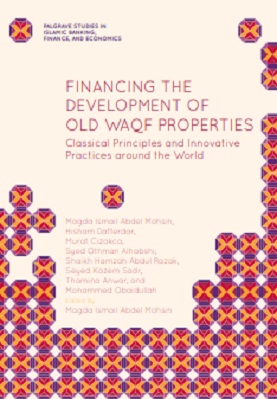
| Financing The Development Of Old Waqf Properties |
| Hamzah Abdul Razak, Hisham Dafterdar, Magda Ismail Abdel Mohsin, Mohammed Obaidullah, Murat Cizakca, Seyed Kazem Sadr, Syed Othman Alhabshi, Thamina Anwar |
| 289 |
| |
| PDF Direct Link |
| Click for Copy from Amazon |
FINANCING THE DEVELOPMENT OF OLD WAQF PROPERTIES – Book Sample
Chapter 5 : Waqf Development: The Islamic Development Bank Experience
The chapter presents several activities, projects and programs carried out by the Jeddah-based IDB Group at strengthening the global waqf sector including a range of interventions, such as: creating a model law of waqf that is forward-looking along with the provision of technical and support services aimed at creating an enabling policy, legal and regulatory environment; undertaking cutting-edge research to document and disseminate good practices;
building capacities through education and training of human resources; recovering lost waqf through proper documentation and legal steps; engineering waqf as part of its developmental operations to provide microfinance; and, finally, managing a fund to raise resources for asset development using state-of-the-art financial structures. Such initiatives are expected to further intensify, as waqf is fully entrenched in IDB’s long-term growth strategy.
Chapter 6 : Modus Operandi and Structures of the Classical and Innovative Modes of Finance
This chapter provides the modus operandi and structures of the classical and the innovative modes of finance for easier adoption by individuals, institutions, organizations, foundations and governments in different countries, in the redevelopment of their old and unproductive waqf properties and in activating waqf socioeconomic role. This chapter is followed by Chap. 7 , the conclusion.
We hope the expected outcome from this research will create aware-ness on the current socioeconomic role of the institution of waqf and also serve as a reference book that can guide individuals, waqf institutions or waqf organizations in the different Muslim societies in redeveloping their old waqf properties by adopting any of modes of finance provided in this study to activate their socioeconomic role, which will benefit their societies.
SPECIAL MESSAGE
While charitable endeavours are often championed in times of eco-nomic prosperity, justifying their funding in leaner times can become more difficult. Yet, all the same, poverty, inequality, access to education or public resources and more are all issues that continue to affect lives regardless of how the economy is running at the moment. This makes the self- sustaining nature of waqfs, operating in perpetuity, all the more important.
As institutions that can stand the test of time, waqfs present an opportunity to provide lasting and useful contributions to society and communities. Property is dedicated by its owner into becoming a waqf, whereupon all revenues from the property, most often land, should be dedicated to a cause stipulated by the founder in perpetuity.
The revenue earned from waqfs may serve any great number of purposes, including scholar-ship funds, mosque construction, cemeteries, healthcare and development of other waqfs . In Muslim minority countries, such as the case of New Zealand examined in this work, waqfs also present an avenue to empower those communities and alter their socioeconomic landscape with the ser-vices they provide, enabling greater access to education and creating social webs.
Across the world, the differing experiences of trustees operating waqfs enlightens us with solutions and innovations to problems experienced elsewhere. While the terrain of these different waqfs might differ, the vari-ous case studies examined within this work provide a starting point for
xii SPECIAL MESSAGE
our understanding; for example, the details of documentation regarding waqf founders’ intentions or the different goals the waqfs pursue. The rigorous documentation and auditing of waqfs in Singapore contrasts with the situation in Indonesia where many existing plots of land dedicated to use as waqfs only retain that status via verbal contracts. There, the usage of waqfs, rather than their scarcity, is cause for concern. Recognizing the charitable endeavors that have been operating around the world and waqfs that have run in all these different environments is an important step to enabling greater research on the subject. The documented experiences in this work may spark the start of greater coordination between these communities the world over and waqfs and, we hope, will continue to improve their operations and provide a means to address social needs and issues.
Though waqfs have occupied a notable segment of history within Islamic finance, a lack of development regarding their structures or practices, in many cases, has led to much of the land dedicated as waqf property falling short of achieving its optimal productivity in serving com-munity needs.
Alongside the establishment of new waqfs, we should also contemplate how existing waqfs can be improved and brought up to more self- sustaining and efficiently run levels. Often, these charitable institutions fall into disarray due to poor management or organization.
As the goal of the waqf to operate in perpetuity is one of the most pertinent fac-tors in its use as a tool to combat issues like poverty, investigating methods of their finance and operation are of much interest.
Thus, the innovative new ventures being explored around the world in regards to developing and redeveloping waqfs would best be examined by anyone interested in their potential. The work of the Islamic Development Bank Group to rejuvenate them, as recounted in this work, may play some part in that development.
Khazanah Nasional acknowledges the vital and pertinent work in this fi eld being conducted by INCEIF, and it has been our duty and privilege to provide some material support.
We hope that this book may help shed more light on an institution that should be revitalized and recognised for all the good it may achieve, insyaAllah .
To read more about the Financing The Development Of Old Waqf Properties book Click the download button below to get it for free
Report broken link
Support this Website
 Don't Miss out any Book Click Join OpenMaktaba Telegram group
Don't Miss out any Book Click Join OpenMaktaba Telegram group